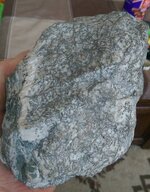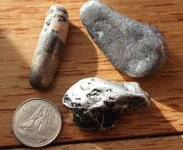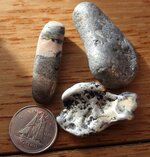meMiner
Bronze Member
- Jul 22, 2014
- 1,047
- 1,177
- Detector(s) used
- Minelab 800,
Fisher CZ21, F75SE, Gold Bug 2.9 & Minelab GPX 5000
- Primary Interest:
- Metal Detecting
Just got back from a weekend detecting in Northern Ontario for silver. It was really hot - both in temperature and results.
On the way up, I dropped into an old gold/silver/copper mine that was hand mined in the early 1900s. I had tried to find it once before - typical problem is the location info is not accurate in the mining reports. This time, while I did not find the main mine, I stumbled across a shallow trench and tailings in the woods. All of the rock was dark brown stained with minor amounts of quartz and calcite - the majority were hot rocks. It did not look like it had been detected before (no holes). With the Gold Bug, I found 4 large rocks that I thought worth further investigation and humped them back to the truck. When I smashed one at the site, I could see/smell the chalcopyrite. I will play with them more at home.
I arrived at my final destination with about 2 hours of daylight remaining and went directly to a silver mine that I had detected once before. It is the most dangerous spot that I know. The hillside is laced with deep trenches and shafts, "protected" by crisscrossing woven wire fencing that is mostly rotted and collapsed. Beside each of these deep holes are piles of loose tailings where one miss-step could result in a slide and a "bad day". Of course, my dog Daisy busted a partridge and decided to chase it up. Luckily, she is a good dog and listened when I called her back.
I detected around one 100' high tailings pile with poor results, so climbed to the top where there were the remains of a number of old structures. One must have been a refinery because the tailings nearby were mixed with small pieces of slag. Slag are the true "uglies", but some actually seem to contain silver. From my last trip, I had sliced one that the detector loved and it appeared to be solid silver inside. I found about a dozen similar this time for the collection pouch. I was mostly detecting on exposed bedrock, looking for smaller-shallow items and got a few 1-3 inch rocks with silver and nickel (green stain). These little guys are heavy and give a great bang on the detector when shallow. On my way out before the sun set, I got a screamer. It was a very strange looking thing from about a foot down. It looks like a concrete homemade anchor, except this looks to be melted silver (instead of lime) with chunks of 3/4 crush. It is about 8 inches wide with a smooth rounded bottom of solid metal. I am thinking it was from a large crucible.
The next day's plan was to meet Sheldon later in the morning at the same site, which gave me an opportunity to explore/scout a different location that I had mapped out. I don't think I found the correct road for the mine, but noticed a trail to a hunt camp where they had used mine tailings to fill in the low spots. Out came the detector and between the road and edge of the private property, I found 8 pieces of high grade silver. The largest was perhaps 5 pounds and some of the other was solid chunks of pure silver vein material. Most of it was right on the surface and required no digging! This must be what it was like to be the first guy with a metal detector. Of course, there was some junk like tin and blasting caps, but what a joy! Just before leaving, an old fellow stopped who thought I was bear hunting and gave permission. So, off to see Sheldon...
I got to the mine site and there was Sheldon carrying out a 30 lb rock containing a nice vein of silver. I was so excited about my new spot and there he was doing spectacular on a chuck of ground that I had previously walked by at least 4 times. All of the targets in that area were deep, so we exhausted ourselves until the afternoon digging both junk and silver. I put on my Go Pro after getting two nice rocks and prior to digging the next good signal. I will post the video:
to be continued.
On the way up, I dropped into an old gold/silver/copper mine that was hand mined in the early 1900s. I had tried to find it once before - typical problem is the location info is not accurate in the mining reports. This time, while I did not find the main mine, I stumbled across a shallow trench and tailings in the woods. All of the rock was dark brown stained with minor amounts of quartz and calcite - the majority were hot rocks. It did not look like it had been detected before (no holes). With the Gold Bug, I found 4 large rocks that I thought worth further investigation and humped them back to the truck. When I smashed one at the site, I could see/smell the chalcopyrite. I will play with them more at home.
I arrived at my final destination with about 2 hours of daylight remaining and went directly to a silver mine that I had detected once before. It is the most dangerous spot that I know. The hillside is laced with deep trenches and shafts, "protected" by crisscrossing woven wire fencing that is mostly rotted and collapsed. Beside each of these deep holes are piles of loose tailings where one miss-step could result in a slide and a "bad day". Of course, my dog Daisy busted a partridge and decided to chase it up. Luckily, she is a good dog and listened when I called her back.
I detected around one 100' high tailings pile with poor results, so climbed to the top where there were the remains of a number of old structures. One must have been a refinery because the tailings nearby were mixed with small pieces of slag. Slag are the true "uglies", but some actually seem to contain silver. From my last trip, I had sliced one that the detector loved and it appeared to be solid silver inside. I found about a dozen similar this time for the collection pouch. I was mostly detecting on exposed bedrock, looking for smaller-shallow items and got a few 1-3 inch rocks with silver and nickel (green stain). These little guys are heavy and give a great bang on the detector when shallow. On my way out before the sun set, I got a screamer. It was a very strange looking thing from about a foot down. It looks like a concrete homemade anchor, except this looks to be melted silver (instead of lime) with chunks of 3/4 crush. It is about 8 inches wide with a smooth rounded bottom of solid metal. I am thinking it was from a large crucible.
The next day's plan was to meet Sheldon later in the morning at the same site, which gave me an opportunity to explore/scout a different location that I had mapped out. I don't think I found the correct road for the mine, but noticed a trail to a hunt camp where they had used mine tailings to fill in the low spots. Out came the detector and between the road and edge of the private property, I found 8 pieces of high grade silver. The largest was perhaps 5 pounds and some of the other was solid chunks of pure silver vein material. Most of it was right on the surface and required no digging! This must be what it was like to be the first guy with a metal detector. Of course, there was some junk like tin and blasting caps, but what a joy! Just before leaving, an old fellow stopped who thought I was bear hunting and gave permission. So, off to see Sheldon...
I got to the mine site and there was Sheldon carrying out a 30 lb rock containing a nice vein of silver. I was so excited about my new spot and there he was doing spectacular on a chuck of ground that I had previously walked by at least 4 times. All of the targets in that area were deep, so we exhausted ourselves until the afternoon digging both junk and silver. I put on my Go Pro after getting two nice rocks and prior to digging the next good signal. I will post the video:
to be continued.
Amazon Forum Fav 👍
Last edited:
Upvote
0













